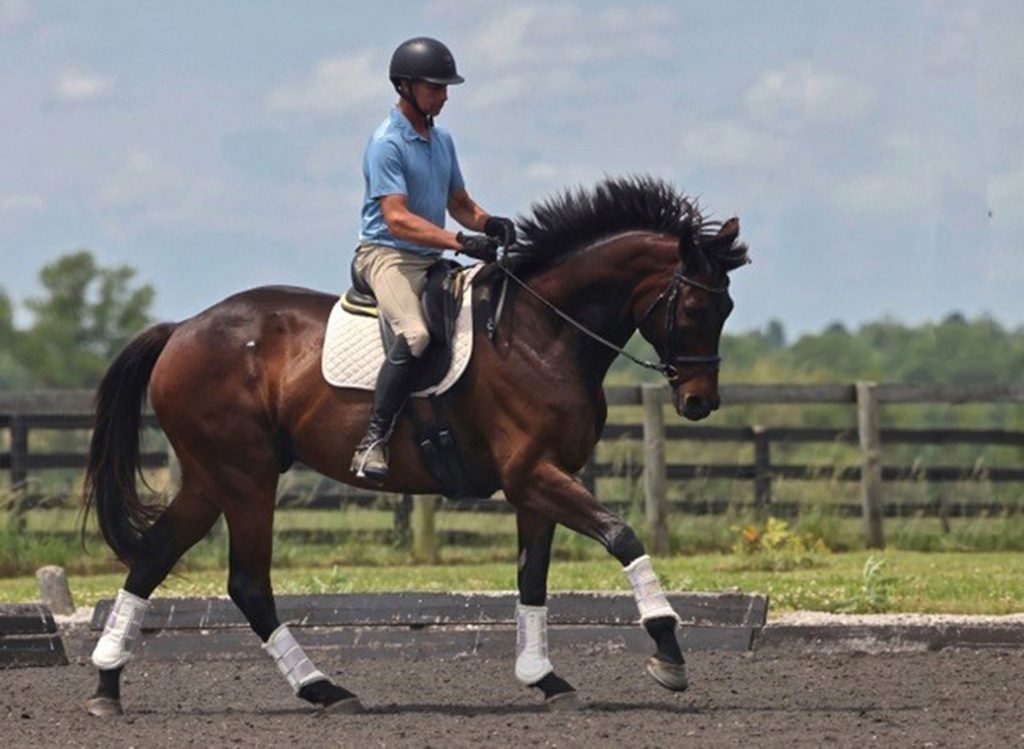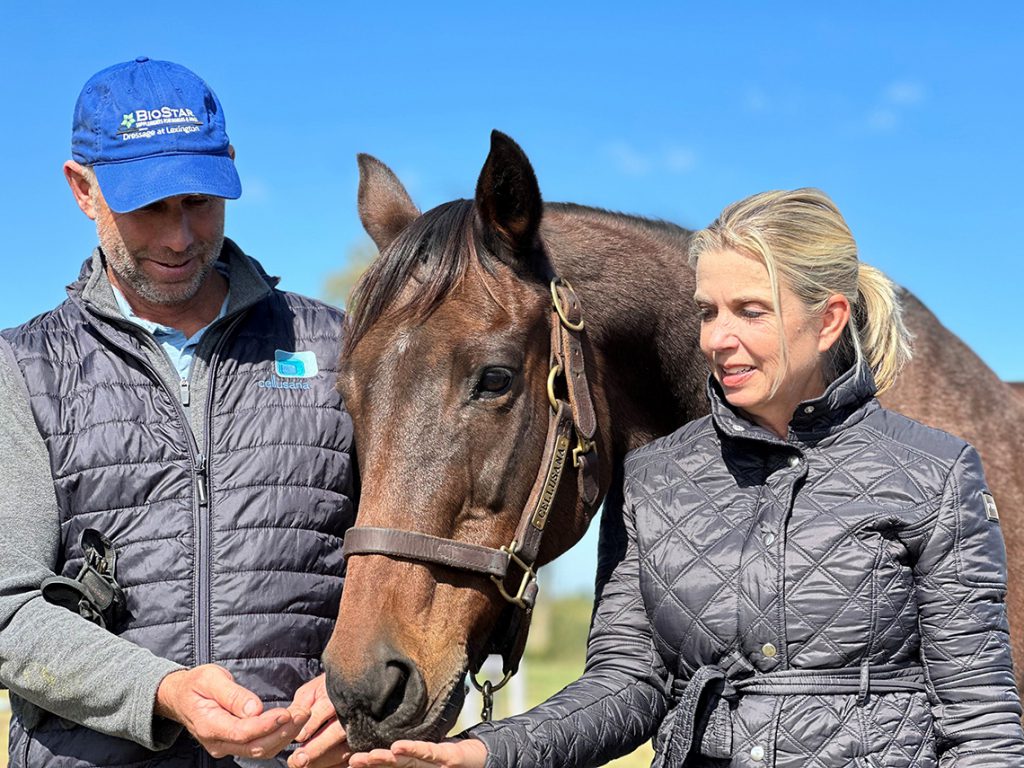By Chris McGrath
The novelist David Mitchell says that all revolutions are fantasy or lunacy-until they happen. “Then,” he adds, “they are historical inevitabilities.”
Who can say, then, how people in the future may look back on an event scheduled this Sunday at the Skylight Horse Park outside Goshen, near Louisville? The inaugural Cross Country Equestrian Competitions (CCE) workshop is a pioneering attempt to reconcile challenges faced by the Thoroughbred and eventing worlds into a shared opportunity. It is the work not of fantasists, or lunatics, but of passionate people who believe that our relationship with Thoroughbreds has reached a crossroads. And it might just turn out to be the start of something big.
CCE has been a long time in the making. You could trace its origins, indeed, two decades back to an afternoon at the Thoroughbred Training Center outside Lexington. A trainer was yelling, “Free horse! Free horse!”
Jeannie Larkin was taken to the stall. The little chestnut filly had scars on her face, a slightly wild look in her eye. But Jeannie thought she looked adorable.
“Sure, I'll take her.”
She told her husband Nick that they had their first Thoroughbred to train. Three or four years previously, in 1998, Nick had become the first winner of the Kentucky Three-Day Event after its addition of a four-star class on an off-the-track Thoroughbred named Red. That same year, Nick and Red represented their native New Zealand in the World Equestrian Games. But Nick was becoming disillusioned. He saw eventing as increasingly elitist–someone offered $300,000 even for Red, who had been a $900 reject, and much higher prices have become routine since–with less space for horsemanship and, not coincidentally, for Thoroughbreds.
As newlyweds, Nick and Jeannie had moved to a little farm on ridgeland near Richmond, Kentucky, and now they were looking to experiment with a Thoroughbred or two. Another trainer heard that they were good people and offloaded a sweet little gelding. They borrowed a neighbor's cattle trailer, and went to pick up the two horses. The filly came out of the barn on two legs.
“We turned her out in a big field and it was a month before we could get a halter on her,” Jeannie recalls. “She was just so done with the world. We had to sit on a bucket in her field to get her to come to us.”
They gave her all the time she needed. One day they finally managed to tack her up, but when Nick mounted she backed, reared and spun her way down the hill, through brambles and thorns over Nick's head.
“I've done enough to know that when you hit these moments, you keep going,” Nick recalls. “You don't stop and say, 'Well, let's just come back to this tomorrow.' And from where we were, there was only one way out.”
So he urged the filly back up the hill until finally she clambered out of the undergrowth.
“And when they got to the top of the hill, she was like, 'Okay, this is my guy,'” Jeannie recalls. “'You've passed the test.' And she just loved Nick after that.”
Gradually they conditioned this ostensibly worthless animal, discarded from the horseracing basement, at what was then the Victory Haven training center. Eventually, two years after her previous start, they tried her-taking along Red as her minder-in a maiden at Ellis Park. She was last out of the gate and steadily retreated from there.
“I mean, it was terrible,” Jeannie admits. “But we bought her tons of carrots and apples on the way home, spoiled her rotten. Didn't want her to think we were disappointed. We'd keep trying.”
They did, with little observable change. One jockey, declaring her to be crazy, jumped off and refused to load. Then they found a rider who was also down on his luck. When they knocked his door, beer cans came flying out. He had once been a promising jockey, but things had gone awry somewhere along the line-not least, Nick suspects, through the exploitation of a generous nature.
“I think racing attracts the optimists,” he says. “And also people that feed on them.”
Together they began to figure the filly out. One day she flew out of the gate and tore off into the lead. She spooked at a puddle, and dropped away, but afterwards they could see her musing on the novelty. It was as though she was saying, “How about that? I can actually do this.”
A couple of starts later, she held on for second; a couple after that, she actually won. It was an undignified grade, a maiden claimer at Beulah, and Nick and Jeannie were the only people outside to watch, the weather was so bad. The jockey's agent told everyone,
“Don't watch the race. Just watch those two out there. You'll know what's happening.”
“When she crossed the line, we were jumping up and down like we had won the Derby,” Jeannie recalls. “It was the best thing ever.”
So where does this take us? A world-class event rider managed to win a $4,000 race at Beulah. Big wow. Well, eventually it will take us to the trialing of a new sport this weekend. But first the Larkins, having taught the filly to love her vocation, had to endure the reverse process: their idealism eroded by the kind of thing they saw at the racetrack.
To be fair, bad practice was not always corrupt. Often it just masked an inability to get on a horse's wavelength. They couldn't believe that every horse was essentially trained the same way; that the only differential appeared to be the caliber of stock. At the sales they saw trainers-and not just what they called the CEO types, with their big entourages-staring at the blandest portion of a horse's conformation and completely failing to notice a luminous point of fragility.
“What they do at a track is nuts,” declares Nick. “It makes no sense at all, as far as actually conditioning a horse. It's the equivalent of athletes walking around the block most days, sprinting 100 meters some days, and then entering the 1,500-meter race. Oh, and they also stay in their room watching TV for 22 or 23 hours a day!”
Nick's parents having sold land to developers in Wainui, on the fringe of Auckland, the Larkins were fortunate in 2017 to move onto what they duly named Wainui Farm, near Paris. They have since been able to devote time and energy to CCE, as well as to the salvage of various discarded horses. [And not just horses: see “They've Taught Me To Be Human Again”, TDN, August 23, 2023.] In the end, however, they have had to acknowledge the reality. As Jeannie puts it: “We can't save them all.”
“It is crushing, because you see so many horses out there trying really, really hard,” Nick says. “A lot of times, when you're trying to turn off-the-track Thoroughbreds into something else, you just say, 'I can't believe they were trying to race you when you were in this condition.' Physically broken, mentally broken. And yet these horses are still trying their hearts out.”
“We did see people that love their horses,” Jeannie stresses.
“Oh, totally,” agrees Nick. “And you can see when horses come off the track, and they've won nothing, but they've been with somebody that cared.”
What he does find distasteful, however, is the disingenuous way people “treat horses like a stock unit, and then suddenly act like they care deeply when a horse wins.” And those in a position to improve things won't do so.
“Because this is working for them,” he explains. “Eventually I realized that racing is nothing more than the marketing arm of the breeding industry. And if everyone does the same thing, training horses, then it comes down to luck and breeding. And breeding will claim all the credit.”
Even with a contracting foal crop, Nick said he felt that much of the problem starts with sheer quantity of production, notably the giant books churned out by unproven new sires. He said he also deplored the surgical interventions that disguise genetic vulnerabilities. We should be breeding animals equal to the questions we ask them; but he also thinks that we could ask them better questions. And that's how he began to ponder new possibilities.
One of the things he most enjoyed about eventing was getting horses to a peak of fitness; and Red, though deemed too slow to race, adapted ideally in this respect.
“When we were at the World Equestrian Games in Rome, he came into the 10-minute box,” Nick recalls. “Normally, horses go in there with 90, 100-plus heart rates. He came in with 52, and dropped to something like 48 or 46. And they said, 'Well, it's not much of a drop.' But that's because he was almost sleeping as he came in.”
In experimenting at the racetrack, the Larkins hoped to unshackle their horsemanship. Eventing, for one thing, depended on subjective judgement. But they also wanted a sport that enabled a slower horse to beat a faster horse, at least in similar classes, simply because it would keep running-both through being trained for stamina, and because superior riding tactics could optimize that. That proved too naïve an aspiration, on the racetrack. But with eventing meanwhile squeezing out certain competences, the Larkins started to think about devising a sport that might fill the gaps.
Nick explains that cross-country, as the middle leg of three-day events, has been diminished by a growing premium on warmbloods, which tend to be more proficient on the first and third days (i.e. dressage/show jumping). At the same time, the affluence required for competitive warmbloods is shutting out riding talent. (Resulting, Nick suggests, in the obviously dangerous equivalent of the kid in a Ferrari.)
So how, Nick asked himself, might you bring together a) those who nowadays find eventing inaccessible and b) those Thoroughbreds lost in the industrial processes of the racetrack? After all, there's a lot of goodwill out there. Nick and Jeannie have seen the passion behind various retraining programs. But the Thoroughbred leaving the racetrack, too often, is a square peg for a round hole. What if a more natural fit could be found?
For an awfully long time, maybe 25 years, Nick has been musing over possibilities. In the last few years, he's been bouncing ideas around and then refining them with organizers, lawyers, insurers. And, on Sunday, they will test the water.
“All the way through, whenever I've told people about it, they're like, 'Wow, this is exciting! We have to do this!'” Nick says.
In CCE, every jump is optional. Points are scored for each one taken, with extra for the more challenging ones; and some will have “knock-down” elements, as when a penalty is incurred for dislodging a show jumping pole. There will be timing faults, too, but the scoring will reward the horsemanship that calculates a prolific jumping score against some incidental time loss. Sure, skills and training will enable you to save time-but that is not quite the same as simply going faster.
“And it's completely objective, which is massively appealing to people who really like eventing but couldn't pay six figures for a warmblood,” Nick enthuses. “The way they're scoring eventing now, you need a dressage horse that can do a little bit of jumping. CCE isn't really about a fast horse, but a fit horse. It rewards training that makes them super adjustable and responsive, so that the partnership can be quick in places where others, less prepared, cannot. The speeds aren't anything like racing, except perhaps occasionally in straight gallop sections. CCE does select to a Thoroughbred because it has a major component of athletic fitness, but it primarily selects to the partnership that knows each other inside-out and so can accomplish things that others can't.”
Meanwhile CCE offers a new lease of life to those Thoroughbreds, like Red, that don't fit the racetrack model. And their affordability is such that this sport can be far more inclusive than either eventing or horseracing.
There will be several grades, from beginner to professional; and a variation in format that permits flexibility in terms of venue. (In fact, the idleness of so many racecourses, for much of the year, was one of the first things that got Nick thinking.)
Clearly, we remain very much at an educative stage. But the potential is infinite.
“This first CCE workshop will be focused on the competitor, organizer, official and competition personnel,” explains Nick, who is scheduling a second event for the Kentucky Horse Park later this month. “We want anyone interested in learning about CCE to come and listen and watch.”
Though infuriated by some of the practices and the resulting wastage on the racetrack, he retains faith in the best of our community.
“There are still good people here,” he says. “Still people that care. If big players and small get behind this, and help it off the ground, then they're no longer just looking after horses that have been beaten up.”
And that takes him to a key point. Because if CCE can take root, then an important message might penetrate.
“There will be demand for a Thoroughbred that's not had its mind blown, and that has not been physically destroyed,” Nick says. “But there will only be a market for these horses if you don't keep banging on them, keep injecting them. So if you decide that this is not a racehorse, or maybe that it's starting to slow down, just stop. Go get another one, and let this one go on and do something else.
“The trouble has been that there's no sport [beyond racing] specifically for the Thoroughbred. That has left people donating just to trim feet and to feed. As it is, we can run around and save a few. But this thing could potentially save thousands.”
Down the line, at an elite level, Nick envisages scope to expand the format. An endurance-style course familiarization day, with vetting; then the centerpiece, an expanded cross-country ride, with ancillary phases [trails with and without jumping; speed and slalom jumping; and a simple gallop]; and then a jump-off ride on the third day that combines various elements [show-jumping, cross-country, speed galloping] on a course with unexpected challenges and opportunities [short-cuts to save time, special jumps to boost scores] designed to ensure an unpredictable and exciting climax.
“CCE selects, incentivizes, develops horsemanship, rather than a singular asset such as movement or jumping scope-attributes that are generally purchased,” Nick explains. “Everything I see and hear suggests that horsemanship is in decline. A lot of horses coming off the track, they're not what I would call trained. They've been taught a pattern of behavior that they just keep repeating. There's no comprehension there. If the horses are a bit more engaged, if they're not hating their life, then they'll try to figure it out. And if they get a trainer or rider that actually has a little bit of feel, they start to connect the dots.
“If you want a horse to do something different, then you won't communicate that by just hanging onto their mouth and pulling hard. Most of the muscles in the neck are actually used for moving the front legs forward. If you bunch them in, force the horse to move in this really awkward way, you're going to mess up the way they move. And that in turn can lead to breaking them down. They're certainly not going to go as fast, or as long.”
As Nick acknowledges, often people do something just because that's the way they saw their parents do it. But he does see a lot of cynicism, too.
“The thing that blows my mind is that people can be so dishonest when dealing with an animal that is just so honest,” he says. “And the horse is just sitting in the middle, not being heard, often becoming collateral damage.”
The Larkins have taken in plenty of animals with no prospect of adapting as sport horses. They've given them a home themselves, or found one elsewhere. [That sweet little gelding, Beeve, by the way, is still out in a field at Wainui. He's now 25.] But how much better, to discover a fresh value in those countless Thoroughbreds that are ultimately rejected by the system.
“For all of us who love horses, how do we change their world?” asks Jeannie. “How can we make a difference, have a legacy, for these $900 horses that don't have a chance?”
Well, maybe we will start to find out on Sunday.
[For more information please visit the CCE website.]
Not a subscriber? Click here to sign up for the daily PDF or alerts.









